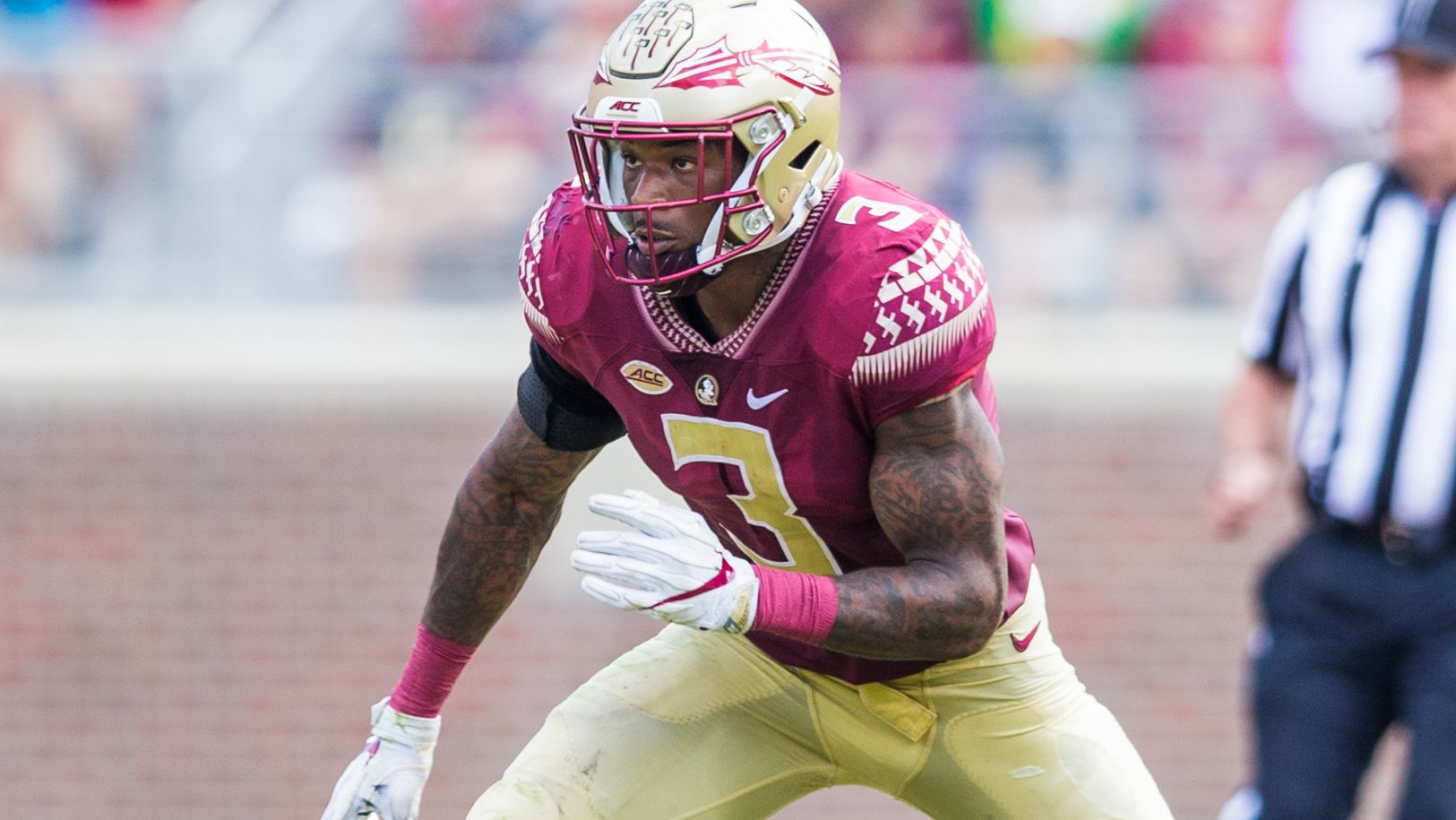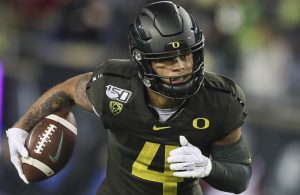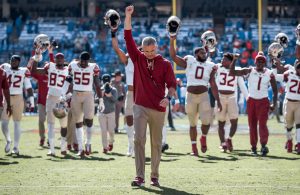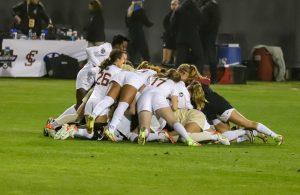- Sunday Seminole Summary: FSU Football Adds Pair of WR Transfers
- Sunday Seminole Summary: FSU Football Exits ESD With Top-15 Class
- Sunday Seminole Summary: FSU Soccer Tops BYU for Third National Championship
- Sunday Seminole Summary: FSU Soccer Advances to National Championship Match
- Seminole Sunday Summary: FSU Soccer Heads Back to College Cup
- Seminole Sunday Summary: FSU Soccer Reaches Sweet 16; Football Tops Boston College
- Seminole Sunday Summary: FSU Soccer Wins ACC, Advances to Second Round of NCAA Tournament; FSU Football Rallies Past Miami
- Seminole Sunday Summary: FSU Soccer Tops Wake on OT to Advance to ACC Final
- Seminole Sunday Summary: FSU Football Crushes UMass for Third Straight Win
- Seminole Sunday Summary: FSU Soccer Stays Perfect with Pair of Wins
Pre-Combine Draft Projections for FSU Players
- By Clint Eiland
- Updated: January 23, 2018
 Ross Obley/FSU athletics
Ross Obley/FSU athleticsIn between the news of college football recruiting and NFL playoffs, the NFL Draft season gets closer by the day. Florida State will once again be well-represented at the combine and the draft itself, as 15 different Seminoles look to pursue an NFL career.
Some of these decisions were obvious. Others were head-scratchers.
Nothing written here is the work of professional scouts. It is simply a preliminary look at where FSU prospects currently project in the draft. There’s a certain range that most find themselves in, which is why trying to pinpoint a specific round is a fruitless task for most players. So much can change and all it takes is one team to pull the trigger.
Where do the 15 former Seminoles look like they’re going to go?
Derwin James, S: Top 15
It is a bit surprising to see James drop out of the top five picks. There’s many reasons for that, but the core of James’ draft stock is still all there. Safety isn’t the most sought-after position; only around three or four ever get drafted in the first round. That means if someone like Minkah Fitzpatrick is taken in the first five picks, it’s most likely by the team who had the biggest need at the position.
James can’t really control the effort of those around him and coaching decisions. This in turn lowered his potential impact over the season, since James had to be used much more in coverage than what many expected. Anyone doubting his physical abilities is still talking nonsense. He is an absolute freak athlete and has everything a team could want in a strong safety. He’s a sure tackler, great pass rusher, and typically does well in coverage. James will test very well at the combine and might even get himself back in the conversation for a top 10 pick.
Tarvarus McFadden, CB: Second to Third Round
Just one season ago it looked like McFadden was going to put himself into the No. 1 cornerback discussion. The Daily Nole attempted to slow down some of the hype surrounding him, but McFadden was already a trendy pick in mock drafts. That he never became the No. 1 cornerback was not shocking; what really confused observers was his complete lack of effort after the Alabama loss this past season.
McFadden might have quite honestly played himself out of the first round. Like James, he has elite measurables for his position, and a solid combine performance could potentially be enough to sneak in towards the end of the round. But once you turn on the tape, you’ll see some bad technique, poor tackling, and general confusion in coverage.
It’s not all bad of course: McFadden still flashed great jamming ability and close out speed on a variety of passes. There is enough to work with that it’s hard to see an NFL team pass him up if he’s still left during the third round. His 2016 season still holds weight and inconsistency does not scare coaches who have made it to the highest level of the game.
Josh Sweat, DE: Second to Fourth Round
No, Josh Sweat never reached his full potential at Florida State. But considering that his football career was in question after a knee injury in high school, Sweat’s performances over the past three years should leave no FSU fan disappointed. Sweat progressed a decent amount in his career and could make an NFL team very happy with more development.
His power off the line will make some scouts drool. Sweat hasn’t even filled out his body, yet he gets consistent push against every lineman he matches up against. His pursuit noticeably improved after 2016 as well as his discipline when setting the edge. He still struggles with going too upright and does not have much of a burst. How much of the latter can be attributed to his injury remains unknown, but it will be enough to keep him outside the top 40 picks.
Derrick Nnadi, DT: Second to Third Round
Nnadi did what was expected of him after a strong 2016 emergence. Of all the defensive players listed, Nnadi lived up to his hype the most. He was unblockable in the middle of the line, and proved to be the most consistent defender on the team. Nnadi combined an underrated pass rush (3.5 sacks) with dominant run defense (53 tackles, 10 tackles for loss) for a great personal season.
The only thing holding Nnadi back from a first round pick is the lack of a high ceiling. Nnadi has already maxed out his frame, with little room to improve in his physical abilities. He’s also solely a 4-3 defensive tackle, which once again limits the number of teams that could take a chance on him early. Nnadi will still almost certainly be gone before the fourth round, and he’s the type of guy who will stay in the league for a while because of his work ethic.
Auden Tate, WR: Second to Third Round
Of all the players on Florida State’s team, none helped their draft stock more than Tate. Even after his starting quarterback went down with an injury in the first game, Tate maintained his focus and became the unquestioned No. 1 receiver.
His body control only got better as the season went on. Tate dominates pretty much any cornerback put on him by high pointing the ball and boxing out the defender. He’s physical, athletic, and has deceptive speed when he’s going downfield. Many compared him to former FSU standout Kelvin Benjamin, but Benjamin was less developed coming out of college. He did have more raw talent, which is probably what’s going to keep Tate out of the first round. Other receivers in the class simply possess more impressive physical attributes.
Still, Tate should make a nice second or third round pick that becomes a starter for many years.
Ryan Izzo, TE: Fifth to Seventh Round
Talk of Izzo departing early for the draft had been present since the season ended, but few thought it was likely. New head coach Willie Taggart really wanted Izzo to stay and be a part of the new offense that he’s installing, but the junior tight end apparently feels that his best shot at the NFL is now.
He does everything pretty well from an evaluation standpoint. No one expects him to be Rob Gronkowski, but Izzo does have a nice mix of blocking ability and receiving ability. He does compare nicely to former FSU tight end Nick O’Leary, though many would say that Izzo is more physically ready for the NFL. This is true, as Izzo is taller and faster, which will play well at the combine. He still does not have the hyper-athlete qualities that many teams are looking for with tight ends in the modern league, so he won’t be going much higher.
Jalen Wilkerson, DE: Undrafted
By far the most shocking draft declaration was Jalen Wilkerson. The redshirt sophomore defensive end was a rotational piece in 2017 that figured to fulfill the same role in 2018. Some more tape on him could’ve been beneficial, and Wilkerson has the talent to actually make meaningful contributions to his draft stock. He’s pretty disciplined as a pass rusher and has decent quickness thanks to his tight end background. But there’s simply not enough to get him drafted.
A source told The Daily Nole earlier this year that Wilkerson’s grades were a major issue, and that he wasn’t going to risk staying around and getting deemed ineligible. If that’s true, then Wilkerson basically has no other choice if he wants to play in the league in some capacity. He could make a decent living as a practice squad player if all else fails.

(Mitch White/FSU athletics)
Matthew Thomas, LB: Fourth to Sixth Round
The greatest disparity between potential draft round and actual draft round will be Matthew Thomas. He has prototypical size, speed, and power to be a dominant linebacker at the NFL level. Unfortunately, he also has character and injury issues that overpower these factors and turn him in to a late round pick.
Whatever team Thomas goes to will have to be patient with his development. He showed flashes of being a great linebacker when he was focused and buying in to the team’s approach. When things went south, he detached himself and simply did not look like the 5-star prospect he was billed as. There’s a feeling that Thomas is a boom-or-bust type of draft pick. He’ll either be a hidden gem that puts it all together, or a total bust that didn’t have the right mindset to succeed.
Jacob Pugh, LB/DE: Fifth to Seventh Round
Florida State used Jacob Pugh as a flexible defender in the front seven, but he projects solely as a 3-4 outside linebacker in the NFL. That lack of specialization in college prevents him from going in the middle rounds. Pugh showed serious promise in 2014 and 2015, but for whatever reason, defensive coordinator Charles Kelly stopped utilizing him in a similar manner for 2016 and 2017.
How good an outside linebacker can he be? Pugh looked very capable as a pass rusher in his limited snaps, and his control when setting the edge looked solid. That being said, it’s unlikely he ever turns into a starter. Pugh is pretty stiff compared to the athletes at his position, and that will only get exploited more at the next level. He’s not completely reliable against the run either.
If a team correctly identifies him as a situational pass rusher, he has a respectable career ahead of him.
Trey Marshall, S: Seventh to Undrafted
Marshall never had the measurables to be a high draft pick at the safety position. He’s undersized and not an elite athlete compared to fellow draft options.
That being said, he could still provide rotational play at strong safety, which tends to help more in run defense. He’s more of a liability when dropping into coverage. Marshall can bring toughness, but it’s seemingly at the expense of actually doing his assigned task on the play. How much of his 2017 decline was due to coaching and how much was his own fault has yet to be determined.
Nate Andrews, DB: Undrafted
The amount of injuries and struggles that Nate Andrews experienced at FSU limit him to undrafted status. He could be like former defensive back Lamarcus Brutus and make practice squad rosters however.
Ro’Derrick Hoskins, LB: Undrafted
Largely the same diagnosis as Andrews. Hoskins can be a thumper when going against run-heavy teams at the very least. But he rarely showed any draftable qualities with his game.
Ermon Lane, DB: Undrafted
Ermon Lane has a nice skill-set to build from. He showed improved instincts and quickness. Lane could eventually make it onto a game day roster with some development as a safety or another secondary position.
Rick Leonard, T: Undrafted
A converted defensive end, Rick Leonard has good physical attributes, but his play rarely matched up with it. Then again, if Bobby Hart could stay in the league for a few years, Leonard has a shot.
Ryan Green, RB: Undrafted
If he has a good combine, Green could actually get some buzz as a seventh-round steal of some sorts. Think of a lesser-known Chris Thompson for reference.




You must be logged in to post a comment Login